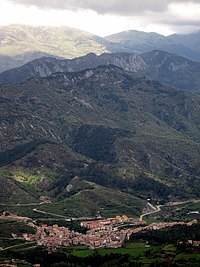La Pobla de Lillet
| Municipality of La Pobla de Lillet | ||
|---|---|---|
| coat of arms | Map of Spain | |
 Help on coat of arms |
|
|
| Basic data | ||
| Autonomous Community : | Catalonia | |
| Province : | Barcelona | |
| Comarca : | Berguedà | |
| Coordinates | 42 ° 15 ′ N , 1 ° 59 ′ E | |
| Height : | 843 msnm | |
| Area : | 51.52 km² | |
| Residents : | 1,095 (Jan 1, 2019) | |
| Population density : | 21.25 inhabitants / km² | |
| Postal code : | 08696 | |
| Municipality number ( INE ): | 08166 | |
La Pobla de Lillet is a village in the Comarca Berguedà on the upper reaches of the Llobregat River in the Spanish province of Barcelona with 1095 inhabitants (as of 2019).
Attractions
Buildings
- Pont Vell , an old bridge from the 14th century
- Castell de la Pobla Illet , a 13th century castle. After it burned down, today's walls were built in the 18th century.
- Parroquia de Santa Maria , a former convent
- Santuari de Falgas , a pilgrimage church in the Romanesque style above the village
Tren del Ciment
A narrow-gauge railway with a gauge of 600 mm was used to transport cement. It operated on the route between Guardiola de Berguedà and Castellar de n'Hug . However, the transport of materials became unprofitable over time. In 1963 the railway was therefore shut down. The line is now operated as a museum railway over a distance of 3.5 km. A ride takes 20 minutes. Stops are:
- La Pobla de Lillet narrow-gauge railway museum on the outskirts
- La Pobla Center in the village center
- Jardins Artigas in a park next to a paper mill outside of town
- Museu del Ciment cement museum
Jardins Artigas
The architect Antoni Gaudí had designed the plan for the Villa Catllaràs for Eusebio Güell. During a visit to the construction site, his friend Artigas asked him for sketches to redesign his garden. Gaudí's design was based on the Parc Güell in Barcelona, and he also sent masons to help design it there. Details of the design are a waterfall, a cave, a picnic area and a gloriette (viewpoint). Gaudí also had a number of Christian symbols incorporated into the buildings. In the course of time the garden was abandoned, it was not restored until 1992 after Gaudi's authorship became known.
Museu del Ciment
The cement museum is located in a former cement works that was built between 1901 and 1904 in Clot del Moro near Castellar de n'Hug in the style of Catalan modernism . One of the founders was Eusebi Güell , who was known in Barcelona as a patron of Catalan modernism. It was in operation until 1975, has been a museum since 1992 and has been a National Heritage Site since 2005. The buildings are located on the upper reaches of the Llobregat River, whose hydropower was and is used to generate electricity. The necessary limestone could be broken on the spot, and coal came from the mines in the area. The factory was equipped with a rotary kiln and was considered extremely modern for its time.
Narrow gauge railway museum
At the La Pobla de Lillet terminus of the narrow-gauge railway there is a narrow-gauge railway museum, in which an exhibition about the small railways, tourist trains and industrial railways in the Llobregat valley is shown (Spanish: Ferrocarrils secundaris, turístics i industrials a la Vall del Llobregat ).
Benet 2 gasoline locomotive with 600 mm gauge from Orenstein & Koppel (Germany), 1934
Steam locomotive from Krauss Lokomotivfabrik (Germany), 1896
HK Porter (USA) steam locomotive with 1000 mm gauge , 1912
Electric locomotive with 500 mm gauge of the AEG , Berlin, 1929
Web links
Individual evidence
- ↑ Cifras oficiales de población resultantes de la revisión del Padrón municipal a 1 de enero . Population statistics from the Instituto Nacional de Estadística (population update).
- ↑ www.trendelciment.cat
- ↑ www.museuciment.cat










